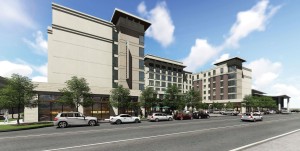Well, just when some of us — me included — thought the Amarillo City Council had driven itself into the proverbial ditch, common sense reared its head at City Hall.
The council voted 3-2 Tuesday to proceed with construction of a downtown convention hotel and an adjacent parking garage.
I’m beginning to breathe a bit more easily with this news.
Joining the common-sense majority was new Councilman Elisha Demerson, who voted along with Councilman Brian Eades and Mayor Paul Harpole to begin work on the twin projects.
Councilmen Mark Nair and Randy Burkett voted “no” on the garage-hotel tandem project, saying they oppose the idea of using public money to compete with private, for-profit enterprise.
This, though, is a classic public-private partnership. Any major economic development effort ought to include some public investment. The city wants to kick in $5 million to help develop retail space in the parking garage — but it will get that money back when it fills that space with successful retailers.
Who benefits from the increased business and the revenue it generates? Let me think. Oh yeah … the public!
The biggest of the three-pronged downtown revival project, the multipurpose event venue, remains in question. Voters will decide on Nov. 3 whether to build an MPEV that includes a ball field. Interestingly, all five council members say they support the concept of a downtown MPEV, but three of them — Demerson, Burkett and Nair — disapprove of the ballpark being part of it.
Therein lies the crux of the disagreement … that and the idea that the city would issue public bonds to build it.
But here’s where — in my view — their anti-MPEV argument falls apart: The city will retire the bonds with revenue derived from guests staying at that downtown hotel, guests at other hotels all across the city and lease payments from whoever agrees to run the MPEV.
The vote Tuesday also provides Potter County with some much-needed parking space and opens up retail opportunities. Imagine for a moment the possibility that retail business could return to the downtown district. Doesn’t that possibility whet the appetites of those who seek to make downtown an attraction instead of a stop along the way to somewhere else?
I am somewhat encouraged by the reason that prevailed at City Hall.
Let’s proceed now with a reasoned, rational and responsible debate on the merits of the MPEV.
